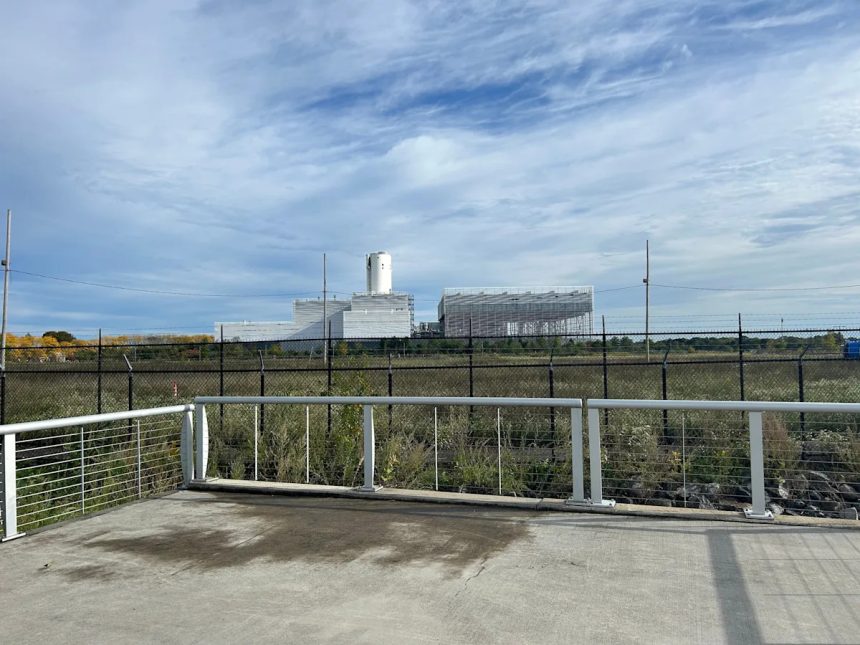Barbara Kelley remembers when her car and windows were routinely coated with a thin film of coal dust that had drifted over from the power plant on the edge of her neighborhood in Salem, Massachusetts. She remembers the noise as a conveyor belt lifted the coal into the building. She also remembers how pleased she was when the community started to discuss the possibility of building an offshore wind terminal on the site when the plant eventually closed.
“The coal plant — it worked, it gave us energy, but it was time to change,” Kelley said. “My reaction was, having a wind port is part of having wind energy — and that’s a good thing.”
In the years since the coal plant shut down in 2014, Kelley and many other community members have worked to promote the goal of transforming part of the property into a staging ground where wind turbine blades, tower sections, and nacelles can be prepared for transport to offshore construction sites south of Cape Cod and north in the Gulf of Maine. The vision was to turn Salem Harbor, one of the country’s oldest ports, into a linchpin of the then-burgeoning offshore wind industry and provide an economic boost to some of Salem’s most disadvantaged residents.
Last year, that dream seemed close at hand. City and state leadership had embraced the idea. The state had promised a hefty investment, and the Biden administration had awarded the project a sizable grant. Massachusetts Gov. Maura Healey attended a groundbreaking ceremony for the development in August 2024, and operations were expected to begin in 2026.
Project developer Crowley had agreed to pour nearly $9 million into a community benefits agreement that included job training, childcare, emergency services, and local sustainability and resilience efforts. Planners estimated construction and operations would create hundreds of jobs. And the whole process of bringing the idea to life gave community members a sense of agency and hope for their city.
Then this August the Trump administration announced that it would cut off $679 million in federal funding for offshore wind ports. The move was part of President Donald Trump’s ongoing attacks on offshore wind, the impacts of which are being felt far beyond the nascent sector. Now, like those in so many communities across the country, the people of Salem find themselves facing the fallout of national political priorities, and wondering whether more than a decade of work will ever bear fruit.
“I feel like we’re all a little bit in the dark still,” said Lucy Corchado, a local activist who was part of the group that negotiated the community benefits agreement. “I hope we hear some good news, but I’m not sure that’s going to happen.”
The path to an offshore wind port
Community advocates first started floating the idea of building a wind port on Salem Harbor roughly 15 years ago. At the time, plans were underway to build a commercial wind farm off Cape Cod, and the coal plant’s closure looked likely. The advocates saw a promising future for the large industrial waterfront parcel in what seemed to be a growing energy sector.
Once the epicenter of the spice trade in early America, Salem has a deepwater port that today serves mostly recreational boaters, tourist outings, and the occasional cruise ship. Though the city is home to a hospital, university, and thriving hospitality sector, it also has a median household income well below the average in most surrounding towns and statewide.
When the owner of the coal plant proposed building a natural gas–burning facility on the site, activists from Salem Alliance for the Environment, or SAFE, were skeptical of replacing one fossil fuel with another. However, they decided not to oppose the plan for a new, smaller plant and to instead push for the rest of the property to be used for an offshore wind port that could both contribute to the decarbonization of the grid and create new opportunities for local residents.
“It wasn’t that we were really supportive of the gas plant, but we had bigger dreams of a wind port coming into town,” said SAFE founder Patricia Gozemba. “Our dream played out.”
In 2022, then-Gov. Charlie Baker, a Republican, announced the state would make a $75 million investment in the port, and the project was also awarded a $34 million grant from the federal Port Infrastructure Development Program. Two years later, the Massachusetts Clean Energy Center bought 42 acres of the former coal plant property, with the intention of leasing it to energy and marine developer Crowley. The City of Salem acquired five adjacent acres.
The plans enjoyed widespread support in the city.
“We’re a uniquely progressive community,” said SAFE executive director Bonnie Bain. There was no organized opposition to the wind port idea beyond occasional grumbling by Facebook commenters, she said.
A seat at the table
As negotiations between Crowley and the city got underway, SAFE and other groups started to worry that, despite their longstanding advocacy for the project, important community input was missing from the process.
“This wasn’t just a wind port — it was an investment in the community,” Bain said. “We want to make sure that when we build projects that they enhance the community.”
Advocates raised their voices, submitting testimony for state and local proceedings, attending planning board meetings, and hosting educational webinars about offshore wind. In 2023, SAFE and several Salem neighborhood associations and civic groups formed a coalition to ask for a seat at the bargaining table as the city and developer hammered out the community benefits agreement.
The coalition was determined to make sure that the project didn’t harm nearby residents and created opportunities for some of the city’s disadvantaged populations. The group met once a week — Thursdays at 4 p.m. — for a year to discuss strategy, write letters to the media, and plan for local and state meetings. Salem Mayor Dominick Pangallo agreed to include two coalition members — Kelley, representing the Historic Derby Street neighborhood adjacent to the planned port, and Corchado, representing The Point, a largely immigrant, lower-income neighborhood nearby — in the community benefit negotiations.
“We kind of pushed our way to the discussion table to make sure they heard what we were looking for,” Corchado said.
The parties struck a deal that included a range of measures. The city’s public schools were set to receive $40,000 annually for technical and vocational education programs and another $50,000 per year to expand prekindergarten childcare to help parents attend job training. Crowley also committed to offer paid apprenticeships and internships, help graduating students find jobs in the industry, and fund scholarships for local workers to access relevant training opportunities.
When Trump was elected in 2024, some port supporters held out hope that the project would escape the president’s well-known hostility to offshore wind. Corchado, however, was concerned from the beginning.
“We were so far along and the funding has already been secured. It was like, maybe it’s not going to be that bad,” she said. “But, yeah … it’s what I was worried about.”
The news on Aug. 29 that the federal funding would be terminated was an enormous disappointment for proponents. It also left them with questions about whether the lost funds would scuttle the plan entirely, force the developer to change course, or merely delay implementation. Crowley will say only that it is reviewing the action and determining next steps. The city of Salem is also figuring out what to do now.
“We are still working to pursue all avenues to address the funding termination,” the mayor’s office said in a statement. “That includes working to get it restored or, failing that, looking at how we could revise the project plan to account for the loss of what was around 10% of the expected construction costs for the port.”
Community members are feeling somewhat adrift as the concrete plans they invested so much time in become increasingly uncertain.
“It wasn’t necessarily surprising,” Bain said. “But it’s still dizzying when it actually happens.”









